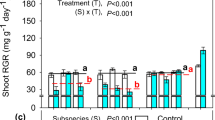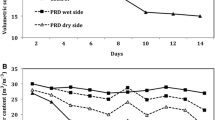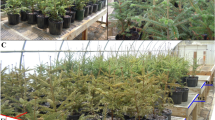Abstract
The effect of irrigation with water at salinity concentrations of 2.6 and 5.2 dS m−1 on the growth of pure swards of six cultivars of white clover (Trifolium repens L.) was examined over three irrigation seasons at Tatura, Victoria, Australia. After two irrigation seasons, soil EC e levels increased to 6 dS m−1 at 0–60 cm depth in the higher salinity treatment resulting in highly significant (p < 0.001) reductions in shoot dry matter production, flowering densities and petiole and stolon densities. These saline conditions also increased (p <0.001) concentrations of Cl and Na in the shoots and reduced (p < 0.001) leaf water potentials and canopy photosynthetic efficiency rates especially at high temperatures. In contrast, root growth increased at shallow depths (0–15 cm) under both saline irrigation treatments (p <0.001). Cultivars differed significantly in salt tolerance (p < 0.001), with cultivars Haifa and Irrigation exhibiting superior tolerance in terms of lower reductions in herbage yield (p <0.05) and petiole densities (p <0.001) during one irrigation season and lower concentrations of Na and Cl in the shoots (p <0.05) compared with the other four cultivars (Aran, Kopu, Pitau and Tamar). In addition, canopy photosynthetic efficiency rates (A *) in plots irrigated with water at 5.2 dS m−1 were higher in cultivar Haifa compared with cultivar Tamar (p <0.05). The salt tolerance ranking obtained for the six cultivars was in broad agreement with earlier greenhouse studies. Consequently, it appears that, while white clover is an extremely salt-sensitive species, it is possible to grow cultivars which display greater salt tolerance than other cultivars and which provide some scope to increase, or at least to maintain, pasture yields in areas where the soil salinity is low to moderate or where pumped saline groundwater is re-used for Irrigation.
Similar content being viewed by others
References
Archer KA, Robinson GG (1989) The role of stolons and seedlings in the persistence and production of white clover (Trifolium repens L. cv. Huia) in temperate pasture on the northern tablelands, NSW. Aust J Ag Res 40:605–616
Beinhart G (1963) Effects of environment on meristematic development, leaf area, and growth of white clover. Crop Sci 3:209–213
Bernstein L, Ayers AD (1951) Salt tolerance of six varieties of green beans. Am Soc Hort Sci 57:243–248
Bernstein L, Hayward HE (1958) Physiology of salt tolerance. Ann Rev Plant Physiol 9:25–43
Best RJ (1929) A rapid electrometric method for determining the chloride content of soils. J Ag Sci 19:533
Blaikie SJ, Martin FM (1987) Limits to the productivity of irrigated pastures in south-east Australia. In: Wheeler JL, Pearson CJ, Robards GE (eds) Temperate pastures their production, use and management. Australian Wool Coorporation CSIRO Melbourne, pp 119–122
Blaikie SJ, Mason WK (1993) Restrictions to root growth limit the yield of shoots of irrigated white clover. Aust J Ag Res 44:121–135
Brown JW, Hayward HE (1956) Salt tolerance of alfalfa varieties. Agron J 48:18–20
Caradus JR, Chapman DF (1991) Variability of stolon characteristics and response to shading in two cultivars of white clover (Trifolium repens L.). NZ J Ag Res 34:239–247
Cerda A, Caro M, Fernandez FG (1982) Salt tolerance of two pea cultivars. Agron J 74:796–798
Downton WJS (1978) Growth and flowering in salt-stressed avocado trees. Aust J Ag Res 29:523–534
Gauch HG, Magistad OC (1943) Growth of strawberry clover varieties and of alfalfa and ladino clover as affected by salt. J Am Soc Agron 35:871–880
Hollington PA, Marshall AH, Hides DH (1993) The effect of row spacing and cover-crop on stolon development and the seed yield components of white clover cultivars of contrasting leaf size. Grass For Sci 48:1–10
Kaddah MT (1962) Tolerance of berseem clover to salt. Agron J 54:421–425
Lauchli A (1984) Salt exclusion: an adaptation of legumes for crops and pastures under saline conditions. In: Staples RC, Toenniessen GH (eds) Salinity tolerance in plants strategies for crop improvement. Wiley, Toronto, pp 171–187
Maas EV, Hoffman GJ (1977) Crop salt tolerance-current assessment. J Irrig Drain Div 103:115–134
Mason WK, Kelly KB, Blaikie SJ, Stockdale CR (1987) New directions for irrigated pastures. Proc 4th Aust Agron Conf La Trobe University, Melbourne, pp 100–117
Mehanni AH, Repsys AP (1986) Perennial pasture production after irrigation with saline groundwater in the Goulburn Valley, Vic. Aust J Exp Agric 26:319–324
Mitchell KJ, Lucanus R (1962) Growth of pasture species under controlled environment. III. Growth at various levels of constant temperature with 8 and 16 hours of uniform lighting per day. NZ J Agric Res 5:135–144
Newton PJ, Myer BA, West DW (1991) Reduction in growth and yield of Jerusalem artichoke caused by soil salinity. Irrig Sci 12:213–221
Noble CL, Hunter CC, Wildes RA (1987) Irrigation of lucerne with saline groundwater on a slowly permeable, duplex soil. Irrig Sci 8:35–48
Noble CL, Shannon MC (1987) Strategies for irrigating white clover with saline water on heavy clays in northern Victoria. Proc 4th Aust Agron Conf Melbourne Australia, p 305
Northcote KH, Hubble GD, Isbell RF, Thompson CH, Bettenay E (1975) Description of Australian Soils. CSIRO Melbourne, pp 102–115
Pearson GA (1959) Factors influencing salinity of submerged soils and growth of Caloro rice. Soil Sci 87:198–207
Richards D, Goubran FH, Garwoli WN, Daly MW (1979) A machine for determining root length. Plant Soil 52:1211–1216
Ritchie GA, Hinckley TM (1975) The pressure chamber as an instrument for ecological research. Adv Ecol Res 9:165–254
Rogers ME, Noble CL, Nicolas ME, Halloran GM (1993) Variation in yield potential and salt tolerance of selected cultivars and natural populations of Trifolium repens L. Aust J Agric Res 44:785–798
Seemann JR, Critchley C (1985) Effects of salt stress on the growth, ion contents, stomatal behaviour and photosynthetic capacity of a salt-sensitive species, Phaseolus vulgaris L. Planta 164:151–162
Skene JKM, Poutsma TJ (1962) Soils and land use in part of the Goulburn Valley, Victoria. Tech Bull 14 Department of Agriculture Victoria
Yeo AR, Caporn SJM, Flowers TJ (1985) The effect of salinity upon photosynthesis in rice (Oryza saliva L.): gas exchange by individual leaves in relation to their salt content. J Exp Bot 36:1240–1248
Author information
Authors and Affiliations
Rights and permissions
About this article
Cite this article
Rogers, M.E., Noble, C.L., Nicolas, M.E. et al. Leaf, stolon and root growth of white clover (Trifolium repens L.) in response to irrigation with saline water. Irrig Sci 15, 183–194 (1994). https://doi.org/10.1007/BF00193686
Received:
Issue Date:
DOI: https://doi.org/10.1007/BF00193686




